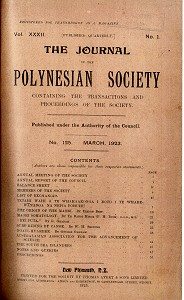 |
surfresearch.com.au
skinner : nz canoe surfing,
1923
|
W. H. Skinner : Canoe Surfing in New Zealand, 1884.
Extract
Skinner, W.H.: Surf-riding by Canoe.
The Journal of Polynesian Society
Volume XXXII Number 1.
No. 125, March 1923, pages 35 to 37.
New Plymouth, New Zealand.
Printed for the Society by Thomas Avery.
